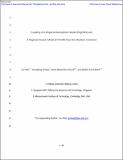| dc.contributor.author | Wei, Jun | |
| dc.contributor.author | Eltahir, Elfatih A. B. | |
| dc.contributor.author | Xue, Pengfei | |
| dc.contributor.author | Xu, Danya | |
| dc.contributor.author | Rizzoli, Paola M | |
| dc.date.accessioned | 2014-06-10T16:39:23Z | |
| dc.date.available | 2014-06-10T16:39:23Z | |
| dc.date.issued | 2013-11 | |
| dc.date.submitted | 2013-07 | |
| dc.identifier.issn | 0930-7575 | |
| dc.identifier.issn | 1432-0894 | |
| dc.identifier.uri | http://hdl.handle.net/1721.1/87722 | |
| dc.description.abstract | Climatological high resolution coupled climate model simulations for the maritime continent have been carried out using the regional climate model (RegCM) version 3 and the finite volume coastal ocean model (FVCOM) specifically designed to resolve regions characterized by complex geometry and bathymetry. The RegCM3 boundary forcing is provided by the EMCWF-ERA40 re-analysis. FVCOM is embedded in the Global MITgcm which provides boundary forcing. The domain of the coupled regional model covers the entire South China Sea with its through-flow, the entire Indonesian archipelago with the Indonesian through-flow (ITF) and includes a large region in the western Pacific and eastern Indian oceans. The coupled model is able to provide stable and realistic climatological simulations for a specific decade of atmospheric–oceanic variables without flux correction. The major focus of this work is on oceanic properties. First, the coupled simulation is assessed against ocean-only simulations carried out under two different sets of air–sea heat fluxes. The first set, provided by the MITgcm, is proved to be grossly deficient as the heat fluxes are evaluated by a two-dimensional, zonally averaged atmosphere and the simulated SST have anomalous cold biases. Hence the MITgcm fluxes are discarded. The second set, the NCEP re-analysis heat fluxes, produces a climatological evolution of the SST with an average cold bias of ~−0.8 °C. The coupling eliminates the cold bias and the coupled SST evolution is in excellent agreement with the analogous evolution in the SODA re-analysis data. The detailed comparison of oceanic circulation properties with the International Nusantara Stratification and Transport observations shows that the coupled simulation produces the best estimate of the total ITF transport through the Makassar strait while the transports of three ocean-only simulations are all underestimated. The annual cycle of the transport is also very well reproduced. The coupling also considerably improves the vertical thermal structure of the Makassar cross section in the upper layer affected by the heat fluxes. On the other hand, the coupling is relatively ineffective in improving the precipitation fields even though the coupled simulation captures reasonably well the precipitation annual cycle at three land stations in different latitudes. | en_US |
| dc.description.sponsorship | Singapore. National Research Foundation (Center for Environmental Sensing and Monitoring (CENSAM)) | en_US |
| dc.description.sponsorship | Singapore-MIT Alliance for Research and Technology (SMART) program | en_US |
| dc.description.sponsorship | National Natural Science Foundation (China) (NSFC, No. 41106003) | en_US |
| dc.language.iso | en_US | |
| dc.publisher | Springer Berlin Heidelberg | en_US |
| dc.relation.isversionof | http://dx.doi.org/10.1007/s00382-013-1986-3 | en_US |
| dc.rights | Creative Commons Attribution-Noncommercial-Share Alike | en_US |
| dc.rights.uri | http://creativecommons.org/licenses/by-nc-sa/4.0/ | en_US |
| dc.source | Prof. Rizzoli via Chris Sherratt | en_US |
| dc.title | Coupling of a regional atmospheric model (RegCM3) and a regional oceanic model (FVCOM) over the maritime continent | en_US |
| dc.type | Article | en_US |
| dc.identifier.citation | Wei, Jun, Paola Malanotte-Rizzoli, Elfatih A. B. Eltahir, Pengfei Xue, and Danya Xu. “Coupling of a Regional Atmospheric Model (RegCM3) and a Regional Oceanic Model (FVCOM) over the Maritime Continent.” Climate Dynamics (November 21, 2013). | en_US |
| dc.contributor.department | Massachusetts Institute of Technology. Department of Civil and Environmental Engineering | en_US |
| dc.contributor.department | Massachusetts Institute of Technology. Department of Earth, Atmospheric, and Planetary Sciences | en_US |
| dc.contributor.department | Singapore-MIT Alliance in Research and Technology (SMART) | en_US |
| dc.contributor.approver | Rizzoli, Paola M. | en_US |
| dc.contributor.mitauthor | Rizzoli, Paola M. | en_US |
| dc.contributor.mitauthor | Eltahir, Elfatih A. B. | en_US |
| dc.contributor.mitauthor | Xue, Pengfei | en_US |
| dc.contributor.mitauthor | Wei, Jun | en_US |
| dc.contributor.mitauthor | Xu, Danya | en_US |
| dc.relation.journal | Climate Dynamics | en_US |
| dc.eprint.version | Author's final manuscript | en_US |
| dc.type.uri | http://purl.org/eprint/type/JournalArticle | en_US |
| eprint.status | http://purl.org/eprint/status/PeerReviewed | en_US |
| dspace.orderedauthors | Wei, Jun; Malanotte-Rizzoli, Paola; Eltahir, Elfatih A. B.; Xue, Pengfei; Xu, Danya | en_US |
| dc.identifier.orcid | https://orcid.org/0000-0003-2431-6838 | |
| dc.identifier.orcid | https://orcid.org/0000-0002-5702-421X | |
| mit.license | OPEN_ACCESS_POLICY | en_US |
| mit.metadata.status | Complete | |
